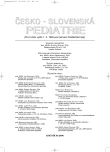-
Medical journals
- Career
Amanita Phalloides Intoxication – Fully Treatable Event. 25-year’s Experience in Children
Authors: S. Dluholucký 1; L. Laho 1; K. Králinský 1; P. Hudec 2; J. Zbojan 1; D. Raffaj 1
Authors‘ workplace: PICU Department of the Pediatric Clinic, Children University Hospital, Banská Bystrica, Slovak Republic 1; Department of Pathology, F. D. Roosevelt University Hospital, Banská Bystrica, Slovak Republic 2
Published in: Čes-slov Pediat 2006; 61 (6): 350-356.
Category: Original Papers
Overview
Authors report their 25 years experience (1977–2003) with the treatment of mushroom Amanita phalloides poisoning in children, using their own protocol established in 1977. Fundamental postulate of treatment was early introduction of protocol treatment based on history of ingestion (type of mushrooms ingested, interval of latency more than 4 hours) and clinical symptoms (intestinal symptomatology). Original protocol was based on intensive elimination of amatoxins from intestines (intestinal lavage, charcoal), forced diuresis with osmotics and administration of high-dose penicillin, silymarin, thioctic acid and high-dose ascorbic acid. Early amendment of protocol was made by introducing fresh frozen plasma and vitamin K supplementation after first occurence of coagulation factors decrease, to mantain them within normal range. Further minimal amendments followed in the course of years, by osmotic forced diuresis with mixture of dextrose + mannitol + low molecule dextran and by making elimination procedures less agressive. Within this period overall 34 children were admitted with amatoxin type of intoxication. Within the period of protocol testing 2 children succumbed to preventable hypoglycemia and intestinal hemorrhage resp. One patient died half a year since intoxication for progressive liver cirrhosis. She was the only one, who underwent hemodialysis on third day after ingestion. Further 3 children were admitted too late – they had signs of terminal multiorgan failure several hours after admission. In all patients who underwent protocol treatment early enough, we witnessed complete recovery i. e. normal clinical status, liver enzymes and above all, no signs of chronic hepatic lesion. Since 1999 we have performed in severe intoxications early liver biopsy (2–3 weeks after ingestion). In all cases only minimal transient changes were found, i. e. mild steatosis of hepatocytes, slight spheric cell infiltration of portobiliar regions, without necrosis or fibrosis or impaired architectonics of hepatocytes resp even in electron microscopy. All survivors are completely healthy. The only weak point was overtreatment in 36% of cases, where entry criteria have been fulfilled and early treatment has been bona fide initiated. In these patients following mycological investigation has not proved amatoxin type of intoxication, hence children had been treated unnecessary. For this reason, early estimation of amatoxins in urine is a key step that can prevent unnecessary treatment. On condition that all mentioned criteria are fulfilled, authors find amanita intoxication as fully treatable event and liver transplantation as failure of protocol treatment.
Key words:
Amanita phalloides, intoxication, protocol of therapy, children
Labels
Neonatology Paediatrics General practitioner for children and adolescents
Article was published inCzech-Slovak Pediatrics

2006 Issue 6-
All articles in this issue
- Is the Prenatal Origin of Acute Myeloid Leukaemia Common?
- Amanita Phalloides Intoxication – Fully Treatable Event. 25-year’s Experience in Children
- Certain Aspects of Family Environment of Czech Children. Results of the ELSPAC Study
- Possibilities of Endoscopic Techniques in Neurosurgery in Solving Hydrocephalus – First Experience with the Use of Laparoscopy
- Hereditary Fructose Intolerance
- Perspective in the Prevention of Childhood Injuries in the Czech Republic
- Guidelines on the Diagnostics, Treatment and Prevention of Infectious Endocarditis in Children. Working Group of Pediatric Cardiology, Czech Society of Cardiology and Czech Society of Pediatrics
- Czech-Slovak Pediatrics
- Journal archive
- Current issue
- Online only
- About the journal
Most read in this issue- Guidelines on the Diagnostics, Treatment and Prevention of Infectious Endocarditis in Children. Working Group of Pediatric Cardiology, Czech Society of Cardiology and Czech Society of Pediatrics
- Amanita Phalloides Intoxication – Fully Treatable Event. 25-year’s Experience in Children
- Hereditary Fructose Intolerance
- Is the Prenatal Origin of Acute Myeloid Leukaemia Common?
Login#ADS_BOTTOM_SCRIPTS#Forgotten passwordEnter the email address that you registered with. We will send you instructions on how to set a new password.
- Career

